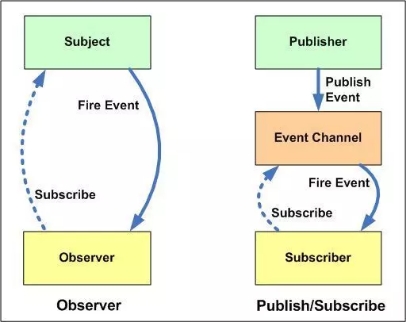一、什么是订阅/发布模式
发布-订阅模式又叫观察者模式
凡是以上边这句话开头的基本都是没理解订阅-发布模式和观察者模式。
订阅/发布模式:发布/订阅模式属于设计模式中的行为(Behavioral Patterns),其中包含发布者(Publisher)和订阅者(Subscriber)以及一个调度中心(Event Channel),发布者和订阅者彼此不需要互相认识,订阅者把自己想订阅的事件注册到调度中心,当发布者发布该事件到调度中心,也就是该事件触发时,由调度中心统一调度订阅者注册到调度中心的处理代码。比如你微信里边订阅得每一个公众号,当你关注这个公众号之后,每当公众号有新得文章发布,就会有消息通知到你,其中你就属于订阅者(Subscriber),公众号就是发布者(Publisher),微信公众号服务中心就是(Event Channel),它会即使把发布者得信息通知到订阅者。
关于观察者模式,链接在这里。
二、有什么用
最开始听说订阅/发布模式还是在Vue的数据双向绑定原理中:通过数据劫持结合发布-订阅模式的方式来实现的。以下订阅发布模式的实际应用,后续又读到相关类似代码添加
DOM元素事件绑定Vue组件传值,on-emitNode.js的`EventEmitter
三、核心点
- "发布"----->调度中心<-----"订阅"
- 发布者和订阅者完全解耦不相关
四、Coding
简易版订阅发布
var pub_sub = {//调度中心
events: {}, //事件中心
subscribe(key, func) {//添加订阅事件
if(!key || !func){
console.log("订阅失败,key:"+key+",func:"+func)
return false;
}
if (this.events[key]) {//是否有这个订阅事件
this.events[key].push(func); //已有订阅事件添加回调函数
} else {
this.events[key] = [func]; //新添加订阅事件
}
console.log("订阅成功,key:"+key+",func:"+func)
return true;
},
publish(event, ...args) {//发布事件
let subscribedEvents = this.events[event]; // 取出所有订阅者的回调函数
if (subscribedEvents && subscribedEvents.length) {
subscribedEvents.forEach((callback) => {//遍历所有的回调
if(typeof callback === `function`){
callback.call(this, ...args);
}
});
}
},
unsubscribe(event, func) {// 删除某个订阅,保留其他订阅
let subscribedEvents = this.events[event];
if (subscribedEvents && subscribedEvents.length) {
this.events[event] = this.events[event].filter(//过滤把同名的删除
(cb) => cb !== func
);
}
}
};
function user1(){
console.log("我user1订阅价格变更通知,收到的信息:"+[...arguments]);
}
function user2(){
console.log("我user2订阅价格变更通知,收到的信息:"+[...arguments]);
}
function user3(){
console.log("我user3订阅价格变更通知,收到的信息:"+[...arguments]);
}
pub_sub.subscribe("priceChange",user1);
pub_sub.subscribe("priceChange",user2);
pub_sub.subscribe("priceChange",user3);
pub_sub.publish("priceChange","价格降下来了,来买吧");
console.log("---user2退订---");
pub_sub.unsubscribe("priceChange",user2);
pub_sub.publish("priceChange","价格涨了,最近别买了");
Vue中$on、$once、$off 、$emit的源码
function eventsMixin (Vue) {
var hookRE = /^hook:/;
Vue.prototype.$on = function (event, fn) {
var this$1 = this;
var vm = this;
// event 为数组时,循环执行 $on
if (Array.isArray(event)) {
for (var i = 0, l = event.length; i < l; i++) {
this$1.$on(event[i], fn);
}
} else {
(vm._events[event] || (vm._events[event] = [])).push(fn);
// optimize hook:event cost by using a boolean flag marked at registration
// instead of a hash lookup
// 优化 hook:event, 如果 _hasHookEvent 为 true,那么在触发各类生命周期钩子的时候会触发
// 如 hook:priceChange 事件
if (hookRE.test(event)) {
vm._hasHookEvent = true;
}
}
return vm
};
//一次绑定事件,等一回调的时候顺便解绑就可以了
Vue.prototype.$once = function (event, fn) {
var vm = this;
// 先绑定,后删除
function on () {//****解绑,回调
vm.$off(event, on);
fn.apply(vm, arguments);
}
on.fn = fn;
vm.$on(event, on);
return vm
};
//解绑事件
Vue.prototype.$off = function (event, fn) {
var this$1 = this;
var vm = this;
// all,若没有传参数,清空所有订阅
if (!arguments.length) {
vm._events = Object.create(null);
return vm
}
// array of events,events 为数组时,循环执行 $off
if (Array.isArray(event)) {
for (var i = 0, l = event.length; i < l; i++) {
this$1.$off(event[i], fn);
}
return vm
}
// specific event
var cbs = vm._events[event];
if (!cbs) {
// 没有 cbs 直接 return this
return vm
}
if (!fn) {
// 若没有 handler,清空 event 对应的缓存列表
vm._events[event] = null;
return vm
}
if (fn) {
// specific handler,删除相应的 handler
var cb;
var i$1 = cbs.length;
while (i$1--) {
cb = cbs[i$1];
if (cb === fn || cb.fn === fn) {
cbs.splice(i$1, 1);
break
}
}
}
return vm
};
//发布事件
Vue.prototype.$emit = function (event) {
var vm = this;
{
// 传入的 event 区分大小写,若不一致,有提示
var lowerCaseEvent = event.toLowerCase();
if (lowerCaseEvent !== event && vm._events[lowerCaseEvent]) {
tip(
"Event "" + lowerCaseEvent + "" is emitted in component " +
(formatComponentName(vm)) + " but the handler is registered for "" + event + "". " +
"Note that HTML attributes are case-insensitive and you cannot use " +
"v-on to listen to camelCase events when using in-DOM templates. " +
"You should probably use "" + (hyphenate(event)) + "" instead of "" + event + ""."
);
}
}
var cbs = vm._events[event];
if (cbs) {
cbs = cbs.length > 1 ? toArray(cbs) : cbs;
// 只取回调函数,不取 event
var args = toArray(arguments, 1);
for (var i = 0, l = cbs.length; i < l; i++) {
try {
cbs[i].apply(vm, args);
} catch (e) {
handleError(e, vm, ("event handler for "" + event + """));
}
}
}
return vm
};
}
/***
* Convert an Array-like object to a real Array.
*/
function toArray (list, start) {
start = start || 0;
var i = list.length - start;
var ret = new Array(i);
while (i--) {
ret[i] = list[i + start];
}
return ret
}
五、小结
订阅/发布模式和观察者模式的区别如下图所示:

订阅发布的核心点是Event Channel调度中心以及发布者和订阅者的完全解耦
观察者模式中,观察者是知道Subject的,Subject一直保持对观察者进行记录
优势
- 完全解耦:发布者不需要知道有多少订阅者,以及订阅者接收到消息之后会干什么,而订阅者也不需要关心发布者会在什么时候发布消息,两者相互独立运行。
- 易维护:得益于松耦合的特性,发布者和订阅者之间没有直接的逻辑往来,也使得逻辑变得清晰可维护,只需要关心内部的逻辑即可。
- 解决负载问题:在后端开发中消息中间件是用来解决写库高并发的常用手段,在前端同样可行。在并发执行量较高的场景下,可以考虑使用消息机制分流,避开执行高峰期,异步执行。
劣势
- 消息无状态:订阅者只会在接收到消息的时候作出响应,但是如果发布者的消息发布失败了,订阅者是不会知道的。
- 订阅者的数量不可控:因为发布者跟订阅者是一对多的关系,所以不会限制订阅者的数量。在发布者发布消息的时候,所有的订阅者都会收到对应的消息。如果订阅者过多,就很容易阻塞住进程,甚至造成
cpu占用过大的情况。 - 发布者和订阅者的关系陌生:在发布订阅模式下,订阅者只认识消息,不认识发布者,所以任何发布者都可以发布指定的消息来通知订阅者,哪怕它是恶意伪装的。